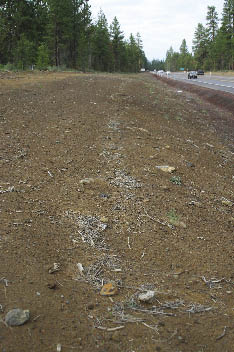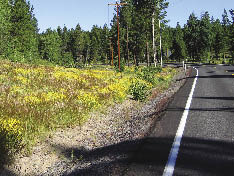7 Planning Phase Four: Integrate and Strategize
7.1 Introduction
In Phase One of the planning process, project objectives were clarified and revegetation units and reference sites were defined. Preliminary Desired Future Conditions (DFCs) were developed for each revegetation unit. During Phase Two, site attributes were defined, including limiting factors, options for mitigation, and available resources. In Phase Three, vegetation was analyzed to consider species, stocktypes, and plant establishment options. In Phase Four, the final phase of planning, the work of all the previous phases is pulled together. Phase Four integrates the understanding of site limitations and resources, mitigation options, species, and seeding or outplanting methods into a comprehensive strategy for revegetating the site. This integrated strategy will culminate in the Revegetation Plan.
The steps for developing the revegetation plan in Phase Four are as follows:
- Finalize revegetation units and DFCs,
- Integrate survey information and develop potential revegetation strategies,
- Compare and select revegetation strategies, and
- Assemble plan.
A case study is provided to illustrate the thought process for the development and selection of revegetation strategies on a project.
7.2 Finalize Revegetation Units and DFCs
Phase Four provides the opportunity to review, refine, and finalize revegetation units and the DFCs for each unit. The boundaries of revegetation units may be revised now that the sites have been more thoroughly surveyed. Additional ecological or management-based information may support creating additional revegetation units. Alternately, if management will be similar, an area originally divided into several revegetation units might be consolidated into one. Once the revegetation units are finalized, the DFCs for each unit can be finalized as well.
DFCs can be revised based on the information gathered during these assessments. For example, with more detail about the local native species and their specific requirements, some factors may emerge as less or more limiting for the species in your project. Water input might be low on the site. However, if native drought-tolerant (xeric) species abound, water will be less limiting for these species than if you were attempting to revegetate with more water-loving (mesic) species. It is possible that less mitigation for water will be necessary than originally assumed. The process of refining DFCs is essential in order to ensure that the objectives are feasible given the native species and ecological processes on the site.
Reference sites provided information on existing vegetation and illustrated what might happen on a site in one year, five years, or several decades. These reference sites model how revegetation units might be expected to respond to change and management. The potential successional development of each revegetation unit should be reviewed. Asking what the revegetation units could look like in both short-term (1-3 years) and long-term (5, 10, 15+ years) timeframes is part of the process for finalizing DFCs.
An example of how DFC's were developed for a project is described in Inset 7.1. In this case study several reference sites were selected, ranging from desirable to undesirable vegetation conditions. Defining site characteristics from a range of reference sites helped develop a realistic DFC for the project.
Site assessments that define limiting factors for each revegetation unit in Phase Two become the basis for developing a revegetation strategy. For example, Figure 7.2 shows how limiting factors were summarized for a proposed project. By listing the limiting factors, the revegetation specialist can focus on only the most important site parameters requiring mitigation. Figure 7.3 lists the potential mitigating measures available in this case study for each limiting factor.
7.3 Integrate and Develop Revegetation Strategies
There are no "silver bullet" products or treatment methods that will transform a project site into a functioning plant community. A comprehensive understanding of the site and how revegetation treatments alone or in combination with other treatments will affect soil characteristics, plant establishment, and future successional processes is the key to successful revegetation. Several revegetation strategies can be developed for each revegetation unit by creating various combinations of mitigating measures. It is important to assess how these strategies compare with each other and how the combination of mitigating measures within a strategy will interact.
Strategies are often developed around major actions or themes. For instance, the three strategies in the case study shown in Inset 7.2 were based on mitigating for the lack of topsoil by:
- Strategy 1: Adding fertilizer,
- Strategy 2: Reapplying topsoil, and
- Strategy 3: Blowing compost mulch.
These are very different approaches, and the resulting strategies will vary considerably.
Developing revegetation strategies is an integrative and collaborative process between vegetation and soils specialists and the project engineers. This requires a good understanding of the site limitations, site resources, and experience with a variety of mitigating measures. All reasonable possibilities should be considered before any are rejected.
7.4 Select a Revegetation Strategy
The spreadsheets shown in Figures 7.2, 7.3, and 7.4 are helpful in summarizing site attributes for defining limiting factors, keeping track of potential mitigating measures, and comparing revegetation strategies for each revegetation unit. Following this process can lead to an informed decision on selecting a revegetation strategy for each revegetation unit.
Figure 7.4 illustrates how strategies can be qualitatively compared. In this method, limiting factors are identified for positive or negative effects on plant growth. Each of these characteristics is assessed for the conditions expected after construction with no mitigation measures employed, and qualitatively given a rating as follows:
- - - Severely limiting + Not limiting
- - Limiting + + Beneficial
- Somewhat limiting + + + Very beneficial
The selection of one strategy over others should be based on revegetation objectives and feasibility of applying the treatment, including considerations for economics, available skills, and resources.
When selecting a strategy, both short-term and long-term planning are required. Mitigating limiting factors for long-term revegetation success however, does not always directly aid in early establishment of plant materials. Success during early plant establishment depends almost entirely on conditions in a narrow environment at the soil surface (six inches above and below the surface), while conditions must focus on soil quality at much deeper depths and aerial factors much higher than the soil surface. Until plants can grow out of this narrow surface zone, they will continue to be affected by climate extremes (moisture, temperature, and so on), competition, and animal damage. The first few weeks after the installation of plant materials is often the most critical period in the revegetation process; plants should not be considered "established" until at least 1 to 2 years of growth. Developing revegetation strategies that meet both short and long-term revegetation goals is not always possible and there will be times when meeting short-term revegetation goals might have to give way to assuring long-term site recover.
7.5 Assemble the Revegetation Plan
At the end of Phase Four, revegetation strategies for all revegetation units have been selected. If the planning process went well, writing the actual plan should simply be a compilation of the various strategies. Revegetation Plans vary in length and depth. At a minimum, a plan will typically include the following components:
- Revegetation objectives,
- Description and map of each revegetation unit;
- Desired future conditions (DFCs) for each revegetation unit;
- Analysis of site attributes (limiting factors and resources) and type of vegetation;
- Description of mitigating measures;
- Description of the revegetation strategy, including plant materials/stocktypes and application methods for each unit;
- Key contacts and responsibilities;
- Budget and timelines;
- Strategies for monitoring achievement of DFCs; and
- Strategies for correcting shortcomings based on monitoring information.
An example Revegetation Plan is provided in Chapter 8.
7.5.1 Networking
The revegetation plan is a valuable tool for communicating with the Federal Highway Administration, other government agencies, and the general public. The degree that a revegetation project succeeds is often proportional to the quality of these interactions. It requires identifying the agency players, affected or key community members, and local and regional workforce (See Chapter 2) and understanding their concerns. The best written plans are of little value if these relationships are not established and maintained. It is important to share versions of the plan with, and solicit input from, others involved in the project.
7.5.2 Timelines
From inception through implementation and monitoring, construction projects span many years. A timeline can help organize the series of steps required for a successful revegetation project, and should include all aspects and details of the project. The timeline is basically a "to do" list with corresponding "due dates." Awareness of timing is crucial, especially when obtaining plant materials. More information on timelines is provided in the Implementation Guide to Obtaining Plant Materials (See Section 10.2).
7.5.3 Fiscal Concerns
Budgets are necessary to estimate costs. Methods to build budgets and timelines are outside the scope of this publication, but there are many resources available to assist with the process.
When the Planning Phase is complete, it will be time to move to the Implementation Phase. During implementation, the Revegetation Plan will be translated into task orders and prescriptions that specify how, when, where, and by whom the plan will be implemented.
7.6 Next Steps
Phase Four, the final phase of the planning process, integrates all the information gathered from the previous three phases. The understanding of limiting factors and resources, mitigation options, species, and planting methods are combined into a comprehensive strategy for revegetating the site. The steps of Phase Four are to: 1) finalize revegetation units and DFCs; 2) integrate survey information and develop potential revegetation strategies; 3) compare and select revegetation strategies; and 4) assemble the plan. A case study with a decision matrix illustrates how to weigh various options and strategies to choose the most appropriate ones for the project. Phase Four culminates in the writing of the Revegetation Plan, which details the strategy and provides schedules and budgets for the project. The Revegetation Plan is an important tool for communicating with agencies, individuals, and the community about the project. An example Revegetation Plan is provided in the next chapter.
| Figure 7.2 — Case Study — Define limiting factors on the site. |
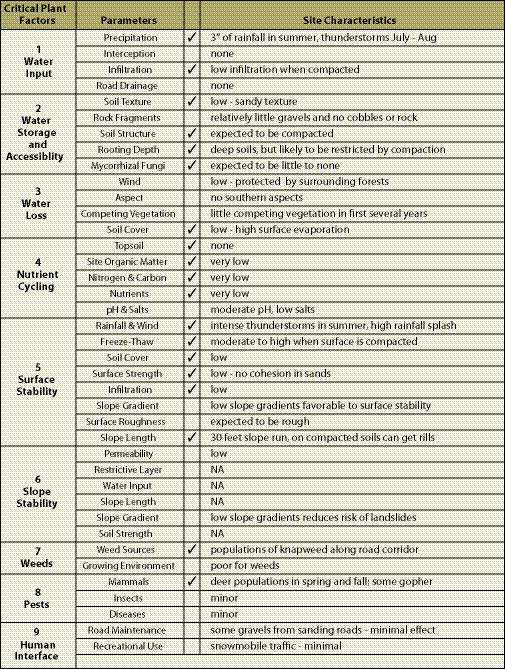 |
| Figure 7.3 — Case Study — List possible mitigating measures for limiting factors. |
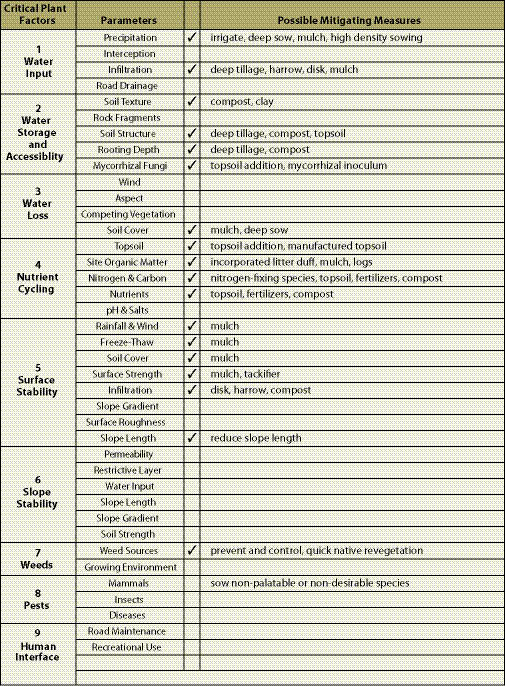 |
Inset 7 .2 — Case Study — Design Potential Revegetation Strategies From the list of possible mitigating measures, design several revegetation strategies. Strategy 1 · Subsoil till the top two feet of soil to break up compaction. · Fertilize with a slow-release fertilizer. · Use working group of nitrogen-fixing species (lupine, ceanothus and bitterbrush) and hydroseed in fall with wood fiber mulch. Short-term and long-term effects Subsoil tillage reduces compaction and increases surface stability by roughening the surface, increasing infiltration and reducing freeze-thaw potential. Subsoil tillage also increases rooting depth. Fertilizers will provide nitrogen and other nutrients for seedling establishment. Sufficient nitrogen may not be present to meet vegetation cover thresholds, but higher nitrogen levels in the soil might encourage annual weed growth. Emergence of sown seeds could be poor, especially if there are periods of dry spring weather during germination. Surface soil holds very little moisture in exposed, dry areas, and the wood fiber in the hydromulch will not provide enough moisture around seeds for germination. Mycorrhizal inoculum is important on dry sites, but has not been added to the hydroseed mix. This could result in poor establishment of seedlings. Discussion This is the least expensive strategy, and the least likely to create conditions for long-term revegetation. Nevertheless, the deep, non-compacted soils, though lacking in organic matter, should be able to support a good stand of nitrogen-fixing species. This could restore nitrogen to the soil and build soil biomass over time. Strategy 2
Short-term and long-term effects Topsoil will increase the water-holding capacity in the surface soil, as well as rooting depth, nutrients, organic matter, infiltration rates, and mycorrhizal inoculum. Knapweed (Centaurea spp.) infestation is possible if care is not taken to avoid areas of knapweed during soil salvage operations. Long-term nitrogen needs for the site are met with the additions of topsoil, but short-term nitrogen availability for seedling establishment might be low. Subsoil tillage increases rooting depth, surface stability through surface roughening, and infiltration. Tillage also reduces the freeze-thaw potential. Application of straw will increase germination and early seedling establishment due to higher humidity around seeds during germination. Straw also protects the soil surface from rainfall splash during thunderstorms. Straw can be a source of weeds if certified straw has not been purchased. Discussion This is the most expensive measure, but will potentially support the highest amount of plant cover over the long-term. All major limiting factors have been mitigated in this strategy. Strategy 3
Short-term and long-term effects Soil moisture is increased around the seeds due to the higher water-holding capacity of compost. Seeds are buried during compost blowing, increasing the chances of germination and establishment. Smaller seeds buried under the deeper thicknesses of compost will have poor emergence. Nutrients are supplied through the compost for short- and long-term plant community needs. Nutrients are not as accessible on the surface of the soil, requiring a portion of the grass and forb root systems to be growing into the compost. Mycorrhizal fungi are supplied through commercial inoculum. Soils are still compacted, limiting rooting depth. Discussion This strategy should be adequate to establish plants. Since soils are still compacted, meeting long-term vegetative cover targets might be difficult. This strategy could be improved if the compost were applied to previously tilled soil, or applied to the surface and then tilled into the soil to mix the compost and loosen the soil. SELECT REVEGETATION STRATEGY Comparing the revegetation strategies with their effects on the limiting factors of the site, a selection of the most appropriate revegetation strategy can be made. Since the amount of topsoil was of limited supply for the project, Strategy 2 (topsoil placement) was selected for the gentler terrain where it could be easily placed. Strategy 3 (mulch application) was selected for the steeper gradients. Strategy 1 was not selected because it was the least likely to meet the revegetation objectives (DFCs) of the project. |
Figure 7.4 — Case Study — Compare revegetation strategies. Evaluate each strategy using a qualitative system for comparison. |
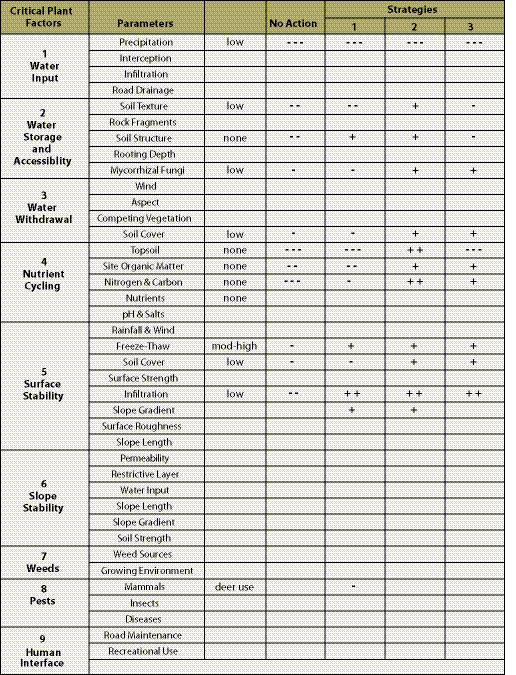 |


